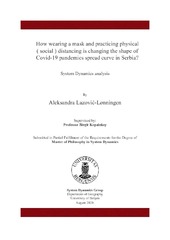| dc.description.abstract | Abstract Severe acute respiratory syndrome coronavirus 2 (SARS-CoV-2), a novel coronavirus, emerged in the city of Wuhan, Hubei, China, in early December 2019. During the time of writing these lines, numbers of infected people reached over 18 million and close to 700,000 deaths all over the globe. On Feb 26, 2020, the rate of increase in cases became greater in the rest of the world than inside China. When it is about official response of the global community, March of 11th, 2020, World Health Organization declared a global pandemic that would rapidly spread to create the worst global public health crisis in the modern history. Two most important elements of the global society were put under the question: public health and resilience of the health systems around the globe. Efficient and effective response of the policy maker, next to early detection of the virus, presented itself as causal necessity in preserving public health in the scenario of pandemics. Expression “flattening the curve” became main buzz all over the globe. Two scenarios came to the light – slowing down the disease via lock-down measures and more relax, as referred to “Swedish scenario” - Sweden decided not to impose a full lock-down on a public life or businesses to “flatten the curve” of the coronavirus epidemics, counting on developing “herd immunity” in shortest period possible, as an assumption. Serbia was among those countries that introduced severe lock down measures, some even addressing them as “draconian”. On 15th of the March, at 20:15 CET, the President of Serbia declared a nationwide state of emergency. Due to effects that pandemics imposed immediately on the global society, about 317,000 Serbian expats headed back to Serbia from all around the globe due to loss of an employment, crossing the border during the first two weeks of the lock-down. This have significantly increased the risk of an infection transmission as most of them came from the regions that have been seriously under the infection already. During May, in the wake of presidential election, measures have been loosened dramatically which resulted in actual peak of infection starting end of June. Agitated by feeling manipulated to believe that pandemics are over, Serbs went demonstrating on the streets breaking the rule of social distancing even more. Policy of wearing masks and practicing social distancing is grounded as the main social strategy tool in dealing with infection spread through “Hammer and the dance” approach in managing the policy. To study the problem through the effects of the measures imposed, the Author considered epidemiological SEIR model ( Susceptible-Exposed-Infected-Recovered ), adding the stock of Deaths and inflow of expats using the system dynamics modelling methodology. The model parameter values have been chosen to be within the range of plausible values for COVID-19, based on the information available throughout the pandemics. Beyond that, estimated parameters were fine-tuned to roughly match the stock of Infected and Death. For the purpose of model calibration in this case-study-research-analysis we used data series from first 137 days of pandemics scenario in Serbia. Conclusion: The results of this study indicate an inextricable link between implementation of combined policy of masks and social ( physical ) distancing and control of infection transmission, thus – total deaths caused by the infection. We compared and validated our policy scenarios results by the model developed at the Institute for Health Metrics and Evaluation at the University of Washington ( IHME ) by following their estimates for 1st of November and 1st of December. The result of our research implies that before the immunization is ready, the most effective way of protecting public health by slowing down the infection with respect to the ongoing SARS-CoV-2 is having in place the policy of masks and social distancing. KEYWORDS: COVID-19, System Dynamics, SEIR, Serbia, social ( physical ) distance, mask, policy, infection transmission. | en_US |
